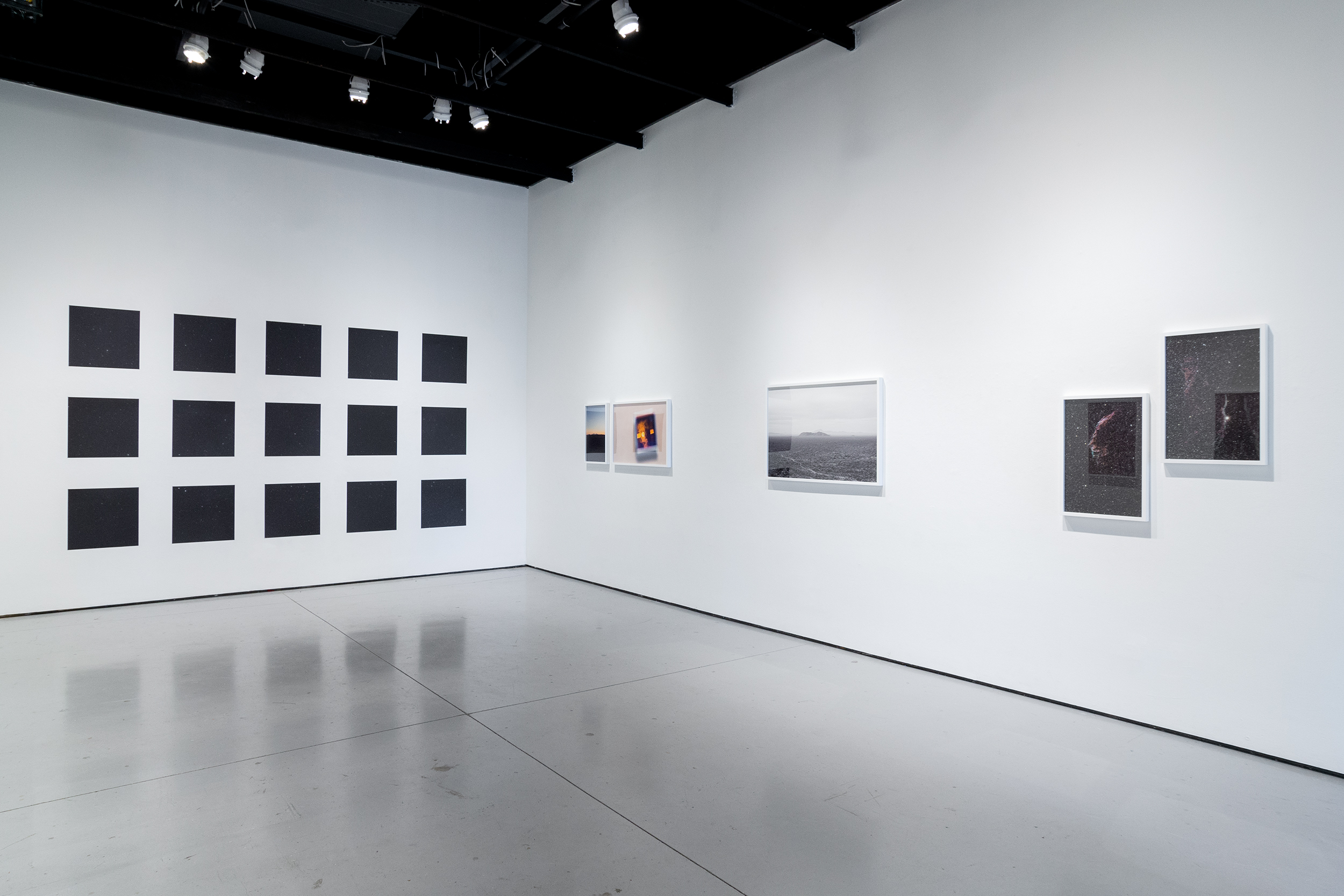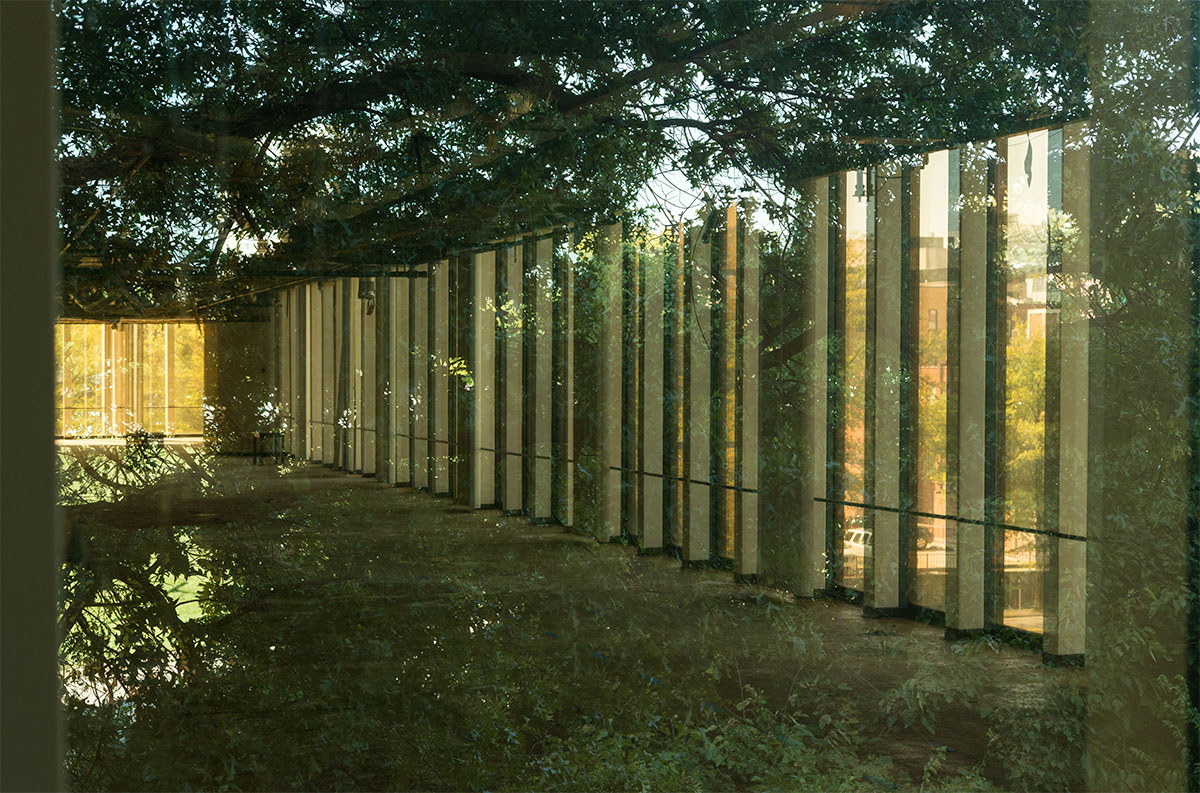The ongoing body of work titled, Stringer’s Ridge, reflects on the act of perceiving a dense and horizonless landscape – specifically, one that resists the conventions of a traditional pictorial scene. Marks overlaid onto the image make reference to drawing, as well the vernacular of surveying and way-finding. Within the shallow field of the print, the combination of marks, surface, and vegetation, creates the possibility of a new space – one that moves between surface and depth, or the recognizable and the undifferentiated. Photographic work is installed alongside 3D printed sculptural diffusers that contain aromatics from honeysuckle plants within Stringer’s Ridge, derived through an extraction process known as enfleurage.
Drift Alignment is an ongoing series that engages with the complex and contested history of the US-Mexico border through the practices of astrophotography and celestial navigation alongside traditional photography and video. The work is driven by an examination of data with respect to the formation of the border, its lasting relationship with colonialism, and the impossibility of visualizing the tragic consequences of immigration enforcement. Throughout the series, works oscillate between attempts at precision and its inverse – both subjective experience and mathematical error – in an attempt to build a more poetic understanding of a region that is frequently reduced to stereotype and cliche.
The series makes use of archival information related to the border surveys of the mid-nineteenth century, eighteenth century Spanish missionary activity, as well as contemporary GIS data for immigrant deaths in Pima County, Arizona. Other imagery comes out of my own experiences living and traveling in the region, as I visit sites tied to my past and present connection with the border, as well as historically significant locations that point to the shifting ways of perceiving and understanding of the lands of southern Arizona and Sonora.
The work I create examines the ways in which humans define physical space while foregrounding the material qualities of the image itself, and its role in shaping perception of the world around us. The feedback loop between imagery and our surroundings creates environments that are both intuitive and strange. It is that oscillation between the familiar and the unexpected that is productive for me, and it is the means by which I seek a different experience of the world.
Curtain Wall uses the gold-mirrored surface of a building as both a literal and symbolic axis around which the interaction between corporate architecture and landscape are examined. Both inside and out, the myriad glass surfaces of the structure create a spectacle of virtual images and reflections that fragment, multiply and color-shift the surrounding landscape. Absent its daily use as a center of human activity – yet showing almost no sign of abandonment or disrepair – the structure’s presence is uncertain and vaguely threatening. The skin of the building functions as both window and screen – displaying floating virtual images of the outdoors while projecting itself far beyond the building site, coating everything in a surreal golden light. Nature is absorbed, reconfigured and highlighted as decoration. The building exists as a form of sculpture, a light-space modulator that reveals both the seductive and alienating qualities of modernist architecture in our everyday lives.
The meeting ground between typical plant life, local terrain, and the built environment generates a rich vernacular, in which complex forms can emerge to create awkward or unexpected scenes. My work is an exploration of these forms and the material artifacts that result from human interaction with, and manipulation of the land.
In part, my photographs are animated by their juxtaposition with one another. The work is an act of comparison between spaces and materials, but also an experiment in the power of images to infect one another with new meanings. In this way the work becomes an investigation into the singular image and its ability to function as a kind of vector for meaning. Differences in scale, medium and subject matter are employed in an effort to slow down perception, and to bring new awareness to the photographic object.
I explore these phenomena in the ongoing body of work titled Hardscape. This series takes a varied approach to the creation of photographic imagery – utilizing studio, street and landscape subject matter – in an effort to speak about the physical world through the means used to control it. The images I make build a new language using plants, architecture, and hardscape; while reinvesting in their potential to inform our understanding of photographic imagery.



